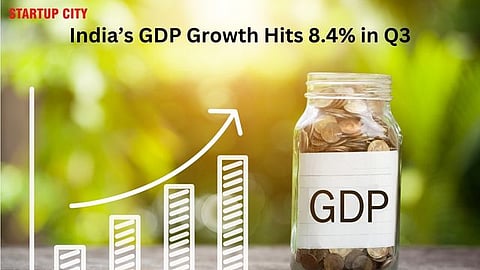

India's economic landscape witnessed a significant upturn as its Gross Domestic Product (GDP) soared to a six-quarter high of 8.4% in the third quarter (Q3) of the fiscal year 2023-24, according to data released by the National Statistical Office (NSO). This surge has surpassed earlier projections, elevating the estimate for the entire fiscal year to 7.6%, a notable increase from the previously anticipated 7.3%. Such a remarkable expansion in GDP not only underscores the resilience but also highlights the immense potential of the Indian economy, prompting positive responses from key stakeholders across various sectors.
The growth trajectory was fueled by stellar performances across multiple sectors. Manufacturing, mining, and financial services exhibited growth rates surpassing 8%, with manufacturing leading the charge at an impressive 11.6% growth in Q3.
Conversely, agricultural growth remained subdued at a mere 0.7%, contributing marginally to the overall economic landscape. Additionally, while private final consumption expenditure experienced a modest rise of 3.5% year-on-year, government final consumption expenditure witnessed a slight decrease of 3.2%.
On the investment front, gross fixed capital formation recorded a notable growth of 10.6% during the third quarter, indicating positive trends in investment activities.
Prime Minister Narendra Modi lauded the robust GDP growth, emphasising its significance in showcasing India's economic strength and potential. In his remarks, he stated, "Robust 8.4% GDP growth in Q3 2023-24 shows the strength of Indian economy and its potential. Our efforts will continue to bring fast economic growth which shall help 140 crore Indians lead a better life and create a Viksit Bharat."
Chief Economic Advisor V Anantha Nageswaran echoed this sentiment, expressing optimism about the economy's momentum and foreseeing continued growth in the fourth quarter. He underscored the ongoing structural transformation, both in physical and digital infrastructure, as well as the inclusive agenda aimed at enhancing the purchasing power of Indian households.
D K Srivastava, Chief Policy Advisor at EY India, emphasised the dominance of non-agricultural growth and substantial investment growth in propelling GDP expansion. However, he also highlighted concerns regarding a slowdown in consumption expenditure growth, which could potentially impact overall economic performance.
Economists are worried about the gap between GDP and Gross Value Added (GVA) growth rates, mainly due to a sharp rise in net taxes. This difference emphasises the need to carefully look at both measures to understand the true state of the economy.
In the future, economists emphasise the need to encourage widespread growth in consumer spending and private investments. Although the positive adjustments in GDP forecasts for FY24 are promising, they also carry risks for future predictions. Therefore, it's essential to closely monitor spending habits and investment patterns to maintain economic momentum in the upcoming quarters.
The strong GDP growth in Q3 2023-24 showcases the strength and promise of India's economy. As the country progresses on its economic journey, it's crucial to focus on boosting consumption, promoting investments, and tackling structural hurdles. These efforts are essential for sustaining long-term and inclusive growth in the future. The encouraging GDP numbers offer optimism for India's economic path, highlighting the importance of strategic actions to capitalise on this positive momentum.